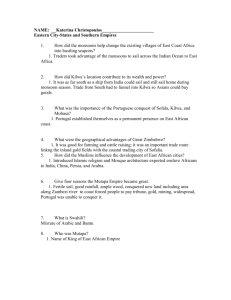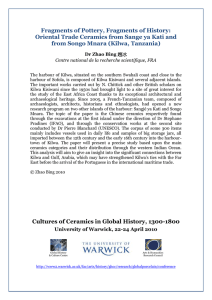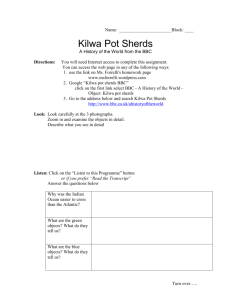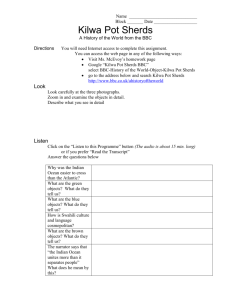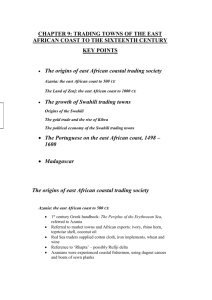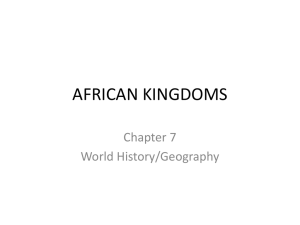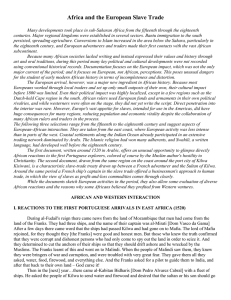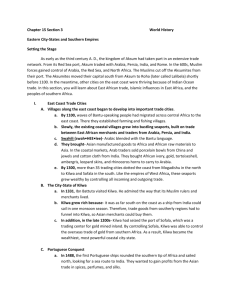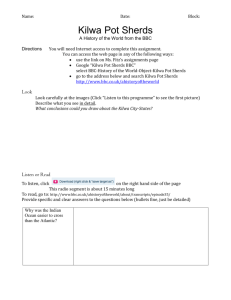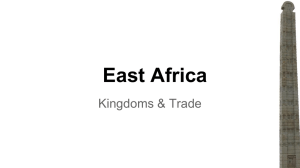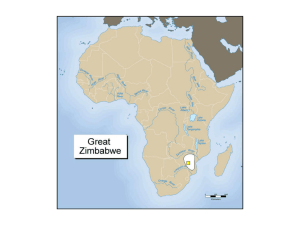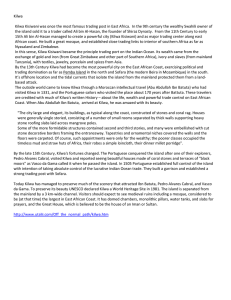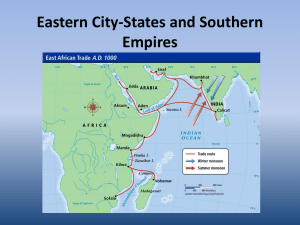VennDiagramReadings-1
advertisement
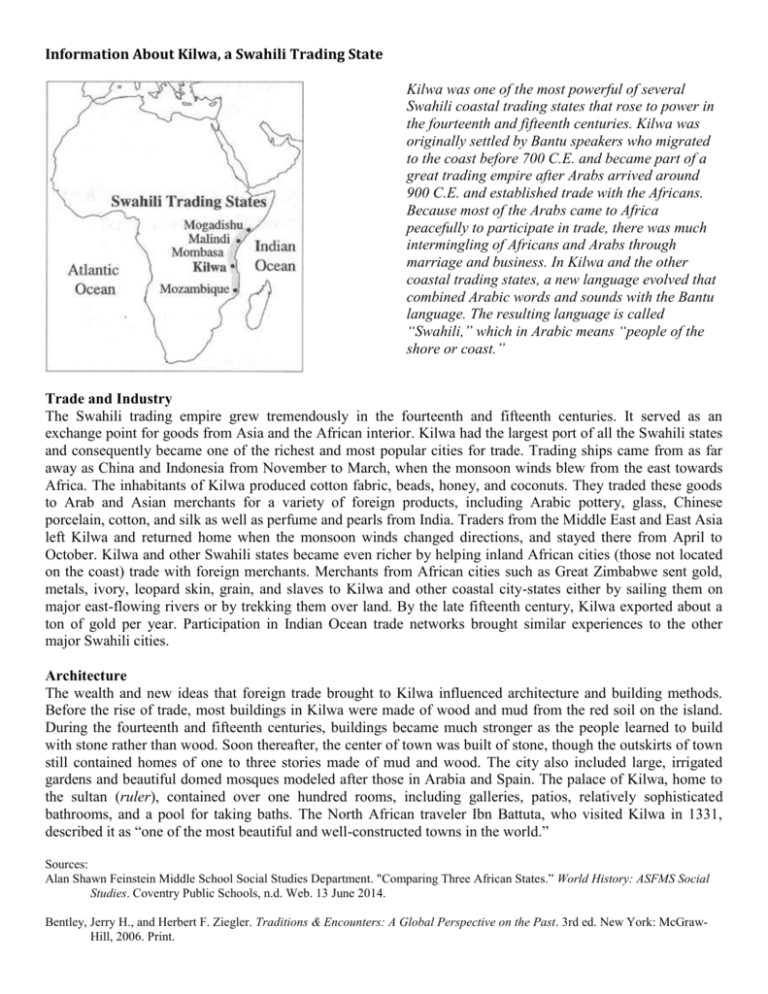
Information About Kilwa, a Swahili Trading State Kilwa was one of the most powerful of several Swahili coastal trading states that rose to power in the fourteenth and fifteenth centuries. Kilwa was originally settled by Bantu speakers who migrated to the coast before 700 C.E. and became part of a great trading empire after Arabs arrived around 900 C.E. and established trade with the Africans. Because most of the Arabs came to Africa peacefully to participate in trade, there was much intermingling of Africans and Arabs through marriage and business. In Kilwa and the other coastal trading states, a new language evolved that combined Arabic words and sounds with the Bantu language. The resulting language is called “Swahili,” which in Arabic means “people of the shore or coast.” Trade and Industry The Swahili trading empire grew tremendously in the fourteenth and fifteenth centuries. It served as an exchange point for goods from Asia and the African interior. Kilwa had the largest port of all the Swahili states and consequently became one of the richest and most popular cities for trade. Trading ships came from as far away as China and Indonesia from November to March, when the monsoon winds blew from the east towards Africa. The inhabitants of Kilwa produced cotton fabric, beads, honey, and coconuts. They traded these goods to Arab and Asian merchants for a variety of foreign products, including Arabic pottery, glass, Chinese porcelain, cotton, and silk as well as perfume and pearls from India. Traders from the Middle East and East Asia left Kilwa and returned home when the monsoon winds changed directions, and stayed there from April to October. Kilwa and other Swahili states became even richer by helping inland African cities (those not located on the coast) trade with foreign merchants. Merchants from African cities such as Great Zimbabwe sent gold, metals, ivory, leopard skin, grain, and slaves to Kilwa and other coastal city-states either by sailing them on major east-flowing rivers or by trekking them over land. By the late fifteenth century, Kilwa exported about a ton of gold per year. Participation in Indian Ocean trade networks brought similar experiences to the other major Swahili cities. Architecture The wealth and new ideas that foreign trade brought to Kilwa influenced architecture and building methods. Before the rise of trade, most buildings in Kilwa were made of wood and mud from the red soil on the island. During the fourteenth and fifteenth centuries, buildings became much stronger as the people learned to build with stone rather than wood. Soon thereafter, the center of town was built of stone, though the outskirts of town still contained homes of one to three stories made of mud and wood. The city also included large, irrigated gardens and beautiful domed mosques modeled after those in Arabia and Spain. The palace of Kilwa, home to the sultan (ruler), contained over one hundred rooms, including galleries, patios, relatively sophisticated bathrooms, and a pool for taking baths. The North African traveler Ibn Battuta, who visited Kilwa in 1331, described it as “one of the most beautiful and well-constructed towns in the world.” Sources: Alan Shawn Feinstein Middle School Social Studies Department. "Comparing Three African States.” World History: ASFMS Social Studies. Coventry Public Schools, n.d. Web. 13 June 2014. Bentley, Jerry H., and Herbert F. Ziegler. Traditions & Encounters: A Global Perspective on the Past. 3rd ed. New York: McGrawHill, 2006. Print. Information About the Zimbabwe State The influence of long-distance trade passed well beyond the coasts to the interior regions of East Africa. The best known of these kingdoms, Zimbabwe, arose to become a powerful state in the fourteenth century and expanded into a great empire in the fifteenth century. The inhabitants were mostly Bantu farmers and cattle raisers who migrated from West Africa three or four centuries earlier. Successful farming and gold mining gave the state the wealth to build the stone city of Great Zimbabwe, which was one of the most magnificent examples of architecture in medieval Africa. Trade and Industry Industry in Zimbabwe included cattle raising, farming, weaving, pottery, iron working, ivory carving, and gold mining. Both men and women participated in gold mining. Gold was removed from the earth by heating rocks by fire and then covering them with icy water. The change in temperature caused the rocks to split, making the gold easier to remove. The people of Zimbabwe did not consider gold very valuable itself, but the Arab merchants of the African coast were eager to trade many other goods for gold and ivory. Because they lived inland, the people of Zimbabwe sent gold and other local products to the coastal city-states, where they were shipped to Kilwa to be traded for foreign products. These imported products included Chinese and Persian pottery and ceramics and Arabic fabric. When Kilwa’s wealth and trading success began to decline, Zimbabwe’s wealth decreased also. Architecture The ruins of the capital city of Great Zimbabwe, which was built between 1000 and 1300, provide one of the most impressive examples of architecture in Africa of the time. In the center of the city stood the Great Temple, which included lookout posts and huge stone walls standing over 30 feet high and made up of over 900,000 stones. These walls protected Zimbabwe from enemy attack (by arrows or swords). The wall around the Temple – 820 feet long, 16 feet thick, and 30 feet high – enclosed a huge, cone-shaped tower, ceremonial shrines, and passageways. The king’s palace, also located inside the temple, included fancy stairs, pathways, hidden passages and floors, and ceilings decorated with gold. Smaller huts surrounding the king’s home were made of straw held together with clay. By the thirteenth century, building technology improved in Zimbabwe. Stone was used increasingly instead of straw, clay and wood. Stone terraces allowed gardens to be built on hills, stone boundaries prevented cattle from running away, and stone walls surrounding courtyards were used for privacy and decoration. Sources: Alan Shawn Feinstein Middle School Social Studies Department. "Comparing Three African States.” World History: ASFMS Social Studies. Coventry Public Schools, n.d. Web. 13 June 2014 Bentley, Jerry H., and Herbert F. Ziegler. Traditions & Encounters: A Global Perspective on the Past. 3rd ed. New York: McGrawHill, 2006. Print.
